Aztec Laws
The Aztecs took law and order very seriously. Their legal system was a complex mix of courts, judges, and cosmic beliefs, all designed to keep society from falling apart.
These laws didn’t exist in a vacuum, they were part of a carefully organized political system. To see how that worked, check out the Aztec Government System, which explains how power flowed from local councils all the way up to the emperor.
You can also explore Aztec politics to understand how power, diplomacy, and law worked together to keep the empire stable — and sometimes ruthless.
Why The Laws Existed
Aztec law controlled and reflected their beliefs about the universe for the people. When the Spanish showed up, they found a system that governed every part of Aztec life. The whole point was to keep crime down, repay victims, and maintain both the emperor's power and cosmic order.
Living on a Slippery Earth
The Aztec worldview revolved around trying to stay balanced on the "slippery earth" (tlalticpac). This idea described the world as a dangerous and unstable place. They believed a single, sacred energy called teotl was in everything, constantly shifting between opposites like order and chaos, or life and death.
Human actions could tip this cosmic scale. The goal was to live a moderate, balanced life, to be "rooted" (neltiliztli). Any excess, good or bad, could bring ruin to you, your family, and even the universe.

The legal system was the government's tool for fixing these imbalances. It was there to enforce moderation and keep people from slipping up.
Crime: Making a Cosmic Mess
This belief shaped their idea of crime. A crime, or tlatlacolli (from a word meaning "to damage"), wasn't like the Christian idea of "sin". It was an act that damaged the world, creating disorder and "filth" (tlazolli) that messed with cosmic balance.
Committing a crime was thought to invite illness and misfortune to your family. So, the courts had to punish the guilty and ritually cleanse the filth their actions created. This gave the government its authority, they were the guardians of universal order.
Where the Laws Came From
Aztec laws came from a few places. Many were based on old customs from other peoples in the Valley of Mexico. Religion was another huge source, as laws were seen as necessary to keep the gods happy, especially the war god Huitzilopochtli.
The emperor (Huey Tlatoani) also issued his own laws. The most famous lawgiver was Nezahualcóyotl, ruler of the city-state Texcoco. He created a code of eighty laws covering everything from treason to robbery, which was so good that other parts of the empire adopted it.
The Courts and Judges
The Aztecs had courts for different levels of society and different types of crimes. The system made sure justice was available locally but ultimately controlled by the emperor. It was a clear ladder of power, from the neighborhood plaza all the way up to the palace.
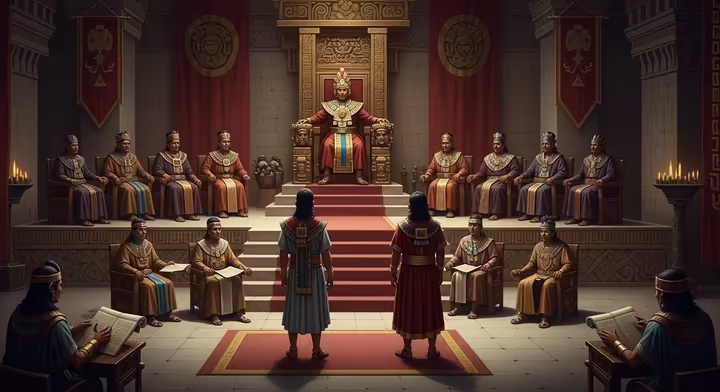
Courts for Everyone
Justice started small, in local courts within each city district (calpulli). These courts handled minor issues and were run by a respected elder or warrior elected by the community. Local assistants acted as a police force, grabbing suspects when needed.
More serious cases moved up to high courts in the capital cities. In Tenochtitlan, this was the teccalco, which had professional judges hearing major criminal cases. Nobles and high-ranking warriors had their own special court, the tlacxitlan, keeping them separate from commoners.
At the very top were the supreme courts, whose decisions were final. Tenochtitlan's supreme court had twelve judges and was overseen by the emperor or his second-in-command, the Cihuacoatl. Texcoco also had a famous Court of Appeal to handle the toughest cases from across the empire.
Special Courts for Special Cases
Some groups had their own courts. The powerful merchant's guild (the pochteca) had a commercial court that could try and even execute people for market crimes, like using fake weights or selling stolen stuff. This showed how important traders were to the empire.
There were also military courts for soldiers, religious courts for priests, and special tribunals in the palace for high-ranking officials. Justice was tailored to who you were and what you did.
Who Were the Judges?
Being a judge was a big deal. Except for the local elected ones, judges came from the noble class and had to be approved by the emperor. They trained at elite schools (calmecac) and then worked as apprentices to learn the ropes.
Judges were held to very high standards. They got a salary from the state so they wouldn't need to take bribes, and being impartial was a must. If a judge was caught being corrupt, the penalty was death, which kept the system honest.
How a Trial Worked
The Aztec court process was a mix of sacred promises and careful paperwork. This made judgments feel both divinely approved and based on facts, so people respected the outcome.
Starting a Lawsuit
A case began when one person formally charged another. The accused was brought to court to face their accuser directly. There were no professional lawyers, but you could bring a friend to help you argue your case, showing that personal stories were valued.
Evidence: Oaths and Paperwork
Evidence was a two-part system, sworn testimony and official records. Everyone involved had to swear a sacred oath to tell the truth by touching the earth and then their lips. This turned a simple statement into a holy vow to the god Huitzilopochtli.
Lying under oath was a huge mistake. The punishment for perjury was whatever the accused would have gotten, so witnesses tended to be honest. The court also used picture-books (codices) painted by scribes (tlacuilos) as legal records of laws, land deeds, and past cases.
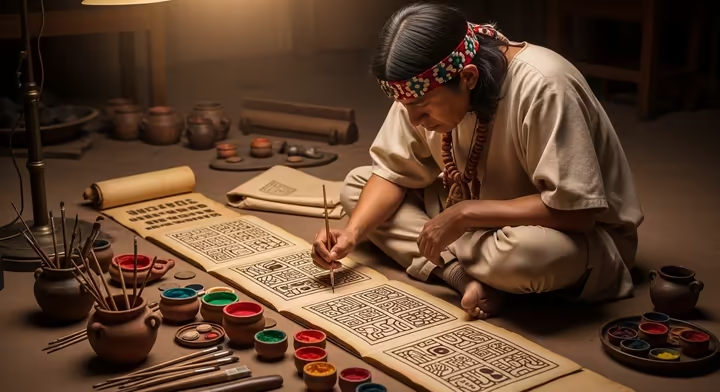
If the sworn testimony matched the state's records, the judgment was considered solid. This made it tough to argue with a final verdict.
Appeals and Deadlines
If you didn't like the verdict from a local court, you could appeal to a higher one. Criminal cases could go all the way up to the supreme courts in Tenochtitlan or Texcoco. But once the supreme court ruled, that was it, no more appeals.
The system was also efficient. No case was allowed to drag on for more than 80 days. This kept things moving and made sure justice was swift.
Carrying Out the Sentence
Once the final judgment was made, law officers known as achcacauhtin took over. They arrested suspects and carried out sentences, which could be anything from public shaming to execution. Punishments were often done in public to serve as a warning to others.
The Laws: Criminal and Civil
Aztec laws were all about keeping society in order. The rules covered everything you can imagine, with punishments that often depended on your social status.
Crime and Punishment
The Aztec criminal code was seriously harsh, partly because they didn't have long-term prisons. Punishments were usually physical, like beatings, slavery, or death. Major crimes that upset the cosmic order, like murder, treason, or witchcraft, were taken very seriously.
For minor theft, you had to pay back what you stole. If you couldn't, you became the victim's slave to work off the debt. But stealing certain things, like from a temple or more than twenty ears of corn from a field, was a capital crime.
Adultery was another capital offense, usually punished by public stoning or strangulation. There was a double standard, a man was only guilty if he was with a married woman, but a married woman was guilty no matter what. The law was really about protecting family bloodlines.
Public drunkenness was a huge no-no. A commoner might get their head shaved and their house knocked down for a first offense, and a second could mean death. For nobles, who were supposed to be role models, one offense could get you executed. Only the elderly (over 70) could drink booze (pulque) freely.
Merchants using fake weights in the marketplace could be executed. Trust was essential for the empire's economy. Even malicious gossip could be a capital crime, since a person's reputation was a big deal in their rigid society.
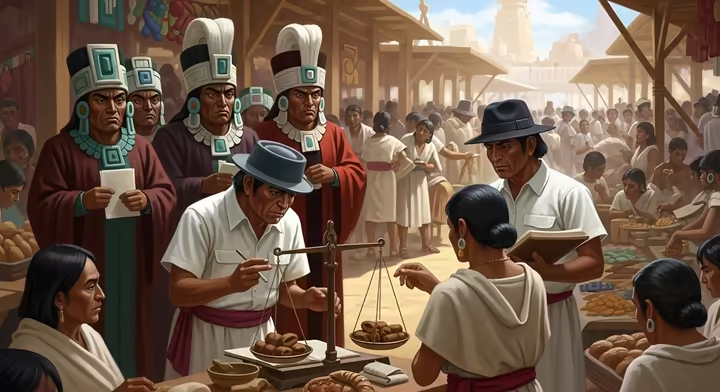
Rules for Daily Life
Civil law handled things like family, property, and work. Marriage was a formal contract, and while most people had one spouse, nobles could have multiple wives to build alliances. Divorce was also legal, property was usually split, and parents divided the kids (fathers took sons, mothers took daughters).
Most land was owned by the community (the calpulli) and given to families to farm, it couldn't be sold. Nobles, however, could own private estates. Women could also own and manage their own property, even when married.
Slavery, or tlacotin, was very different from European slavery. It was not a permanent, inherited, or race-based condition. You could become a slave to pay off a debt, as punishment for a crime, or even sell yourself into it during a famine.
Slaves (tlacotin) had legal rights. They could marry free people, own property, have kids who were born free, and even own their own slaves. They had several legal ways to get their freedom back, and it was illegal for a master to abuse them. It was more like a system of forced labor for debt than permanent bondage.
Law and Social Class
The law was designed to keep the Aztec class system in place. It wasn't the same for everyone, it reflected your status and responsibilities in life.
Laws for Your Class
The system was built to separate nobles (pipiltin) from commoners (macehualtin). This was most obvious with sumptuary laws, rules about who could use luxury goods.
For example, only nobles were allowed to wear cotton clothes, certain types of jewelry, drink cacao, or even carry flowers. A commoner who broke these rules was committing a crime. These laws made the social hierarchy obvious in everyday life.
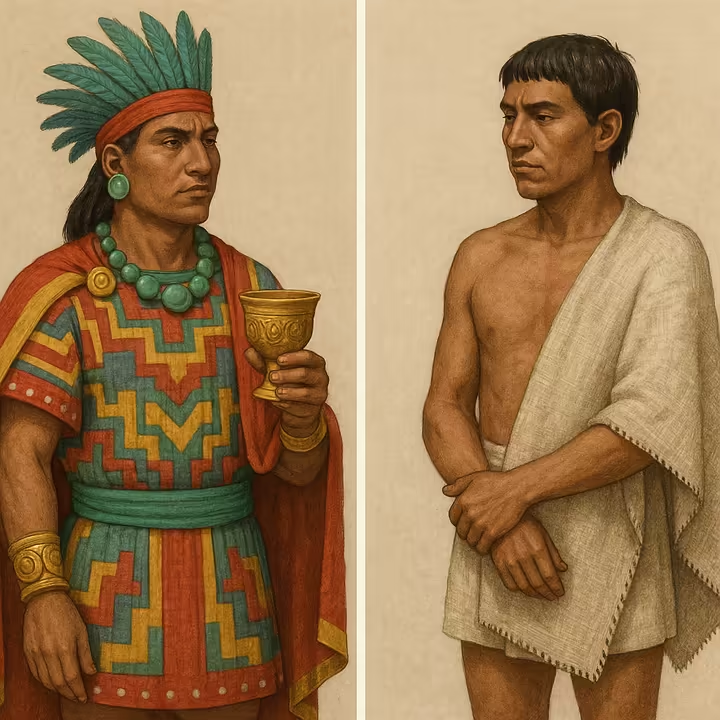
Tougher on the Rich
Here's a twist, nobles often got harsher punishments than commoners for the same crime. A noble caught drunk in public could be killed for a first offense. A commoner might just get their head shaved.
The thinking was that nobles, with all their education and privilege, had a greater duty to act right. Their crimes caused more "damage" to the social order. By holding them to a higher standard, the state made the system seem fair, which kept everyone in line.
Justice for a Regular Person
For an average commoner (macehualli), the law was just a part of life. They would most likely deal with the local calpulli court, which was public and run by an elected neighbor. You could take someone to court for a minor theft and get a fair hearing.
But the system was severe. The constant threat of a harsh punishment for something like getting drunk was a powerful way to control society.
Confession and Public Shame
Public humiliation was a common punishment, especially for a first offense. Getting your head shaved and marched through the market used social pressure to correct bad behavior.
There was also a spiritual option. A person could, once in their life, confess their crimes to a priest of the goddess Tlazolteotl, the "Eater of Filth." The confession was thought to transfer the "filth" of the crime to the goddess, purifying the person. This was about spiritual healing, not avoiding punishment from the courts.
What We Don't Really Know
The Aztec legal system was complex and effective. It linked social rules to cosmic beliefs, using a hierarchy of courts and a strict legal code to maintain order. It reinforced the class system while also holding the powerful accountable.
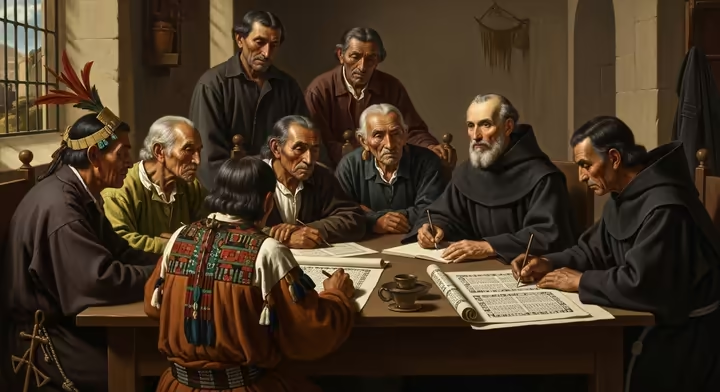
But our knowledge is incomplete. Most of what we know comes from sources like the Florentine Codex, written after the Spanish conquest. These accounts were filtered through a European, Catholic lens, so native ideas like tlatlacolli were often misunderstood as "sin."
Big gaps remain in the historical record. We know a lot more about criminal law than civil law. While the basics are clear, many details of how the Aztec laws really worked day-to-day are lost to time.